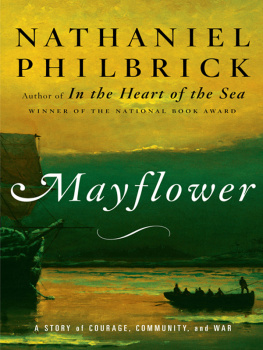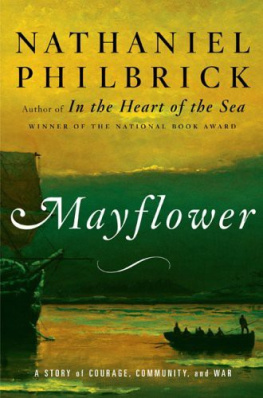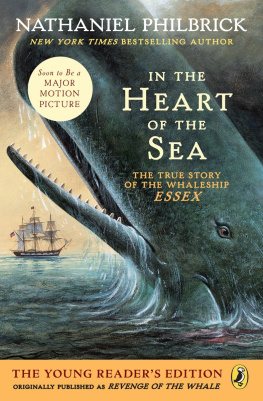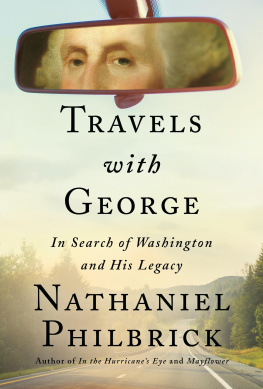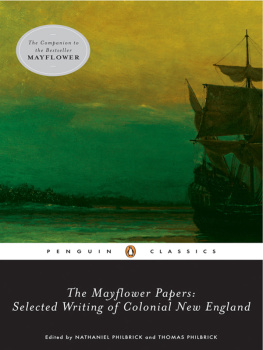ALSO BY NATHANIEL PHILBRICK
The Passionate Sailor
Away Off Shore: Nantucket Island and Its People, 16021890
Abrams Eyes: The Native American Legacy of Nantucket Island
Second Wind: A Sunfish Sailors Odyssey
In the Heart of the Sea: The Tragedy of the Whaleship Essex
Sea of Glory: Americas Voyage of Discovery, the U.S.
Exploring Expedition, 18381842

VIKING
Published by the Penguin Group
Penguin Group (USA) Inc., 375 Hudson Street, New York, New York 10014, U.S.A. Penguin Group (Canada), 90 Eglinton Avenue East, Suite 700, Toronto, Ontario, Canada M4P2Y3 (a division of Pearson Penguin Canada Inc.) Penguin Books Ltd, 80 Strand, London WC2R 0RL, England Penguin Ireland, 25 St. Stephens Green, Dublin 2, Ireland (a division of Penguin Books Ltd) Penguin Books Australia Ltd, 250 Camberwell Road, Camberwell, Victoria 3124, Australia (a division of Pearson Australia Group Pty Ltd) Penguin Books India Pvt Ltd, 11 Community Centre, Panchsheel Park, New Delhi110 017, India Penguin Group (NZ), Cnr Airborne and Rosedale Roads, Albany, Auckland 1310, New Zealand (a division of Pearson New Zealand Ltd) Penguin Books (South Africa) (Pty) Ltd, 24 Sturdee Avenue, Rosebank, Johannesburg 2196, South Africa
Penguin Books, Ltd, Registered Offices: 80 Strand, London WC2R 0RL, England
First published in 2006 by Viking Penguin, a member of Penguin Group (USA) Inc.
Copyright Nathaniel Philbrick, 2006
Maps copyright Penguin Group (USA) Inc., 2006
All rights reserved
Maps by Jeffrey L. Ward
Illustration credits appear at the end of this book.
LIBRARY OF CONGRESS CATALOGING IN PUBLICATION DATA
Philbrick, Nathaniel.
Mayflower: a story of courage, community, and war / Nathaniel Philbrick.
p. cm.
Includes bibliographical references and index.
ISBN: 978-1-1012-1883-9
1. Pilgrims (New-Plymouth Colony) 2. MassachusettsHistory
New-Plymouth, 16201691. 3. Bradford, William, 15901657.
4. Church, Benjamin, 16391718. I. Title.
F68.P44 2006
973.2'2dc22 2005058470
Without limiting the rights under copyright reserved above, no part of this publication may be reproduced, stored in or introduced into a retrieval system, or transmitted, in any form or by any means (electronic, mechanical, photocopying, recording or otherwise), without the prior written permission of both the copyright owner and the above publisher of this book. The scanning, uploading, and distribution of this book via the Internet or via any other means without the permission of the publisher is illegal and punishable by law. Please purchase only authorized electronic editions and do not participate in or encourage electronic piracy of copyrightable materials. Your support of the authors rights is appreciated.
To Melissa
Contents
Discovery
They Knew They Were Pilgrims
Dangerous Shoals and Roaring Breakers
Into the Void
Beaten with Their Own Rod
The Heart of Winter
In a Dark and Dismal Swamp
Thanksgiving
Accommodation
The Wall
A Ruffling Course
Community
One Small Candle
The Ancient Mother
The Trial
War
Kindling the Flame
The God of Armies
In a Strange Way
The Better Side of the Hedge
Conscience
List of Maps
Tracks of the Speedwell and the Mayflower, JulyNovember 1620
Track of the Mayflower off Cape Cod, November 911, 1620
Tracks of the Three Exploring Expeditions, November 15December 12, 1620
Plymouth Harbor
New England, 16251674
Mount Hope Region, JuneJuly 1675
Southern New England and New York during King Philips War, 16751676
Preface: The Two Voyages
W E ALL WANT TO KNOW how it was in the beginning. From the Big Bang to the Garden of Eden to the circumstances of our own births, we yearn to travel back to that distant time when everything was new and full of promise. Perhaps then, we tell ourselves, we can start to make sense of the convoluted mess we are in today.
But beginnings are rarely as clear-cut as we would like them to be. Take, for example, the event that most Americans associate with the start of the United States: the voyage of the Mayflower.
Weve all heard at least some version of the story: how in 1620 the Pilgrims sailed to the New World in search of religious freedom; how after drawing up the Mayflower Compact, they landed at Plymouth Rock and befriended the local Wampanoags, who taught them how to plant corn and whose leader or sachem, Massasoit, helped them celebrate the First Thanksgiving. From this inspiring inception came the United States.
Like many Americans, I grew up taking this myth of national origins with a grain of salt. In their wide-brimmed hats and buckled shoes, the Pilgrims were the stuff of holiday parades and bad Victorian poetry. Nothing could be more removed from the ambiguities of modern-day America, I thought, than the Pilgrims and the Mayflower.
But, as I have since discovered, the story of the Pilgrims does not end with the First Thanksgiving. When we look to how the Pilgrims and their children maintained more than fifty years of peace with the Wampanoags and how that peace suddenly erupted into one of the deadliest wars ever fought on American soil, the history of Plymouth Colony becomes something altogether new, rich, troubling, and complex. Instead of the story we already know, it becomes the story we need to know.
In 1676, fifty-six years after the sailing of the Mayflower, a similarly named but far less famous ship, the Seaflower, departed from the shores of New England. Like the Mayflower, she carried a human cargo. But instead of 102 potential colonists, the Seaflower was bound for the Caribbean with 180 Native American slaves.
The governor of Plymouth Colony, Josiah Winslowson of former Mayflower passengers Edward and Susanna Winslowhad provided the Seaflower s captain with the necessary documentation. In a certificate bearing his official seal, Winslow explained that these Native men, women, and children had joined in an uprising against the colony and were guilty of many notorious and execrable murders, killings, and outrages. As a consequence, these heathen malefactors had been condemned to perpetual slavery.
The Seaflower was one of several New England vessels bound for the West Indies with Native slaves. But by 1676, plantation owners in Barbados and Jamaica had little interest in slaves who had already shown a willingness to revolt. No evidence exists as to what happened to the Indians aboard the Seaflower, but we do know that the captain of one American slave ship was forced to venture all the way to Africa before he finally disposed of his cargo. And so, over a half century after the sailing of the Mayflower, a vessel from New England completed a transatlantic passage of a different sort.
The rebellion referred to by Winslow in the Seaflower s certificate is known today as King Philips War. Philip was the son of Massasoit, the Wampanoag leader who greeted the Pilgrims in 1621. Fifty-four years later, in 1675, Massasoits son went to war. The fragile bonds that had held the Indians and English together in the decades since the sailing of the Mayflower had been irreparably broken.
King Philips War lasted only fourteen months, but it changed the face of New England. After fifty-five years of peace, the lives of Native and English peoples had become so intimately intertwined that when fighting broke out, many of the regions Indians found themselves, in the words of a contemporary chronicler, in a kind of maze, not knowing what to do. Some Indians chose to support Philip; others joined the colonial forces; still others attempted to stay out of the conflict altogether. Violence quickly spread until the entire region became a terrifying war zone. A third of the hundred or so towns in New England were burned and abandoned. There was even a proposal to build a barricade around the core settlements of Massachusetts and surrender the towns outside the perimeter to Philip and his allies.

